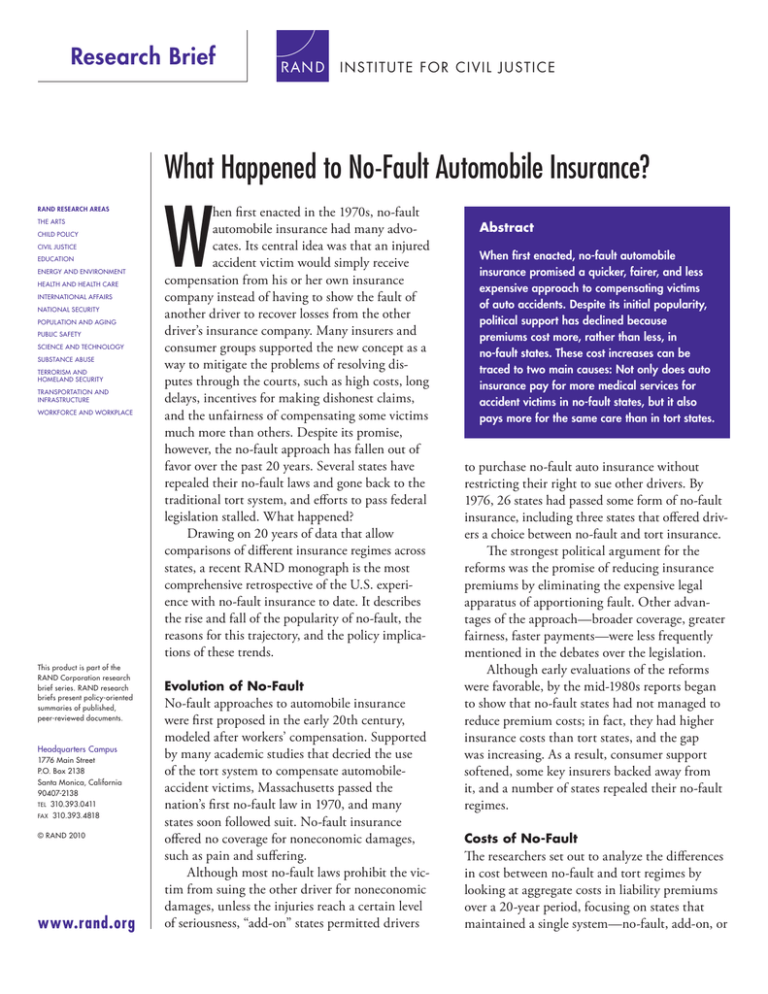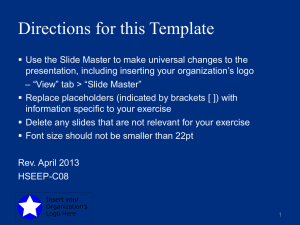W What Happened to No-Fault Automobile Insurance? Research Brief
advertisement

Research Brief IN S TITUTE F O R C IV IL JUS TIC E What Happened to No-Fault Automobile Insurance? RAND RESEARCH AREAS THE ARTS CHILD POLICY CIVIL JUSTICE EDUCATION ENERGY AND ENVIRONMENT HEALTH AND HEALTH CARE INTERNATIONAL AFFAIRS NATIONAL SECURITY POPULATION AND AGING PUBLIC SAFETY SCIENCE AND TECHNOLOGY SUBSTANCE ABUSE TERRORISM AND HOMELAND SECURITY TRANSPORTATION AND INFRASTRUCTURE WORKFORCE AND WORKPLACE This product is part of the RAND Corporation research brief series. RAND research briefs present policy-oriented summaries of published, peer-reviewed documents. Headquarters Campus 1776 Main Street P.O. Box 2138 Santa Monica, California 90407-2138 TEL 310.393.0411 FAX 310.393.4818 © RAND 2010 www.rand.org W hen first enacted in the 1970s, no-fault automobile insurance had many advocates. Its central idea was that an injured accident victim would simply receive compensation from his or her own insurance company instead of having to show the fault of another driver to recover losses from the other driver’s insurance company. Many insurers and consumer groups supported the new concept as a way to mitigate the problems of resolving disputes through the courts, such as high costs, long delays, incentives for making dishonest claims, and the unfairness of compensating some victims much more than others. Despite its promise, however, the no-fault approach has fallen out of favor over the past 20 years. Several states have repealed their no-fault laws and gone back to the traditional tort system, and efforts to pass federal legislation stalled. What happened? Drawing on 20 years of data that allow comparisons of different insurance regimes across states, a recent RAND monograph is the most comprehensive retrospective of the U.S. experience with no-fault insurance to date. It describes the rise and fall of the popularity of no-fault, the reasons for this trajectory, and the policy implications of these trends. Evolution of No-Fault No-fault approaches to automobile insurance were first proposed in the early 20th century, modeled after workers’ compensation. Supported by many academic studies that decried the use of the tort system to compensate automobileaccident victims, Massachusetts passed the nation’s first no-fault law in 1970, and many states soon followed suit. No-fault insurance offered no coverage for noneconomic damages, such as pain and suffering. Although most no-fault laws prohibit the victim from suing the other driver for noneconomic damages, unless the injuries reach a certain level of seriousness, “add-on” states permitted drivers Abstract When first enacted, no-fault automobile insurance promised a quicker, fairer, and less expensive approach to compensating victims of auto accidents. Despite its initial popularity, political support has declined because premiums cost more, rather than less, in no-fault states. These cost increases can be traced to two main causes: Not only does auto insurance pay for more medical services for accident victims in no-fault states, but it also pays more for the same care than in tort states. to purchase no-fault auto insurance without restricting their right to sue other drivers. By 1976, 26 states had passed some form of no-fault insurance, including three states that offered drivers a choice between no-fault and tort insurance. The strongest political argument for the reforms was the promise of reducing insurance premiums by eliminating the expensive legal apparatus of apportioning fault. Other advantages of the approach—broader coverage, greater fairness, faster payments—were less frequently mentioned in the debates over the legislation. Although early evaluations of the reforms were favorable, by the mid-1980s reports began to show that no-fault states had not managed to reduce premium costs; in fact, they had higher insurance costs than tort states, and the gap was increasing. As a result, consumer support softened, some key insurers backed away from it, and a number of states repealed their no-fault regimes. Costs of No-Fault The researchers set out to analyze the differences in cost between no-fault and tort regimes by looking at aggregate costs in liability premiums over a 20-year period, focusing on states that maintained a single system—no-fault, add-on, or Comparative Trends in Liability Premium Average written liability premium (year-2000 $) 750 No-fault Optional add-on Tort 700 650 600 550 500 450 400 1986 1988 1990 1992 1994 1996 1998 2000 2002 2004 Year tort—over the whole period. As shown in the figure, liability premiums have been consistently higher in no-fault states, and the gap has widened over time. By 2004, premiums under no-fault were 50 percent higher than those under tort. These differences persist even after partially controlling for other factors that may influence these costs, such as climate, the road system, and density of the population. The researchers also documented liability premium costs over the same period in three states that repealed no-fault: Georgia, Connecticut, and Colorado. The results are striking. As soon as no-fault was repealed, the price of liability premiums dropped by 10 to 30 percent in all three states. The researchers highlighted two main causes for the high cost of no-fault. First, auto insurance pays for a larger number of medical services in no-fault states than in tort states, whether measured as hospital stays or visits to the emergency room, chiropractor, dentist, or psychotherapist. Second, automobile insurance pays more for the same medical services in no-fault states, and this difference has increased over time. Although medical costs were roughly comparable in no-fault and tort states in 1987, within ten years they had more than doubled in no-fault states. Further research is necessary to determine exactly why medical costs in no-fault states grew so dramatically over this period. But interviews with a range of experts highlighted several possible reasons for this trend: • In most no-fault states, medical providers bill auto insurers before billing the victim’s medical insurance, effectively shifting costs from the medical insurance system to the auto insurance system. • Under the tort system, health insurers have developed sophisticated techniques for managing medical care to minimize costs. Auto insurers, which are serving as medical insurers under no-fault, have less specialized expertise in this area. • Health insurers have more flexibility than auto insurers in writing contracts that limit care. Other Trends Although no-fault initially appeared to reduce court involvement in the settlement of auto claims, this advantage has eroded over time. In terms of attorney utilization, litigation rates, and payment of noneconomic damages, the difference in the two systems has largely disappeared. Even rates of overclaiming (or exaggerating the cost of claims), initially lower in no-fault states, have gradually converged across the two systems. Policy Lessons The authors offer several proposals for controlling costs under no-fault regimes, such as prioritizing first-party medical insurance over automobile insurance for medical costs. They also offer evidence that a system that allows drivers to choose between no-fault and tort insurance may function better than conventional no-fault. Furthermore, technological innovation (such as autonomous-vehicle technology) and insurance reform (such as pay-as-you-drive auto insurance and universal health care) may make no-fault systems more desirable in the future. ■ This research brief describes work done for the RAND Institute for Civil Justice documented in The U.S. Experience with No-Fault Automobile Insurance: A Retrospective, by James M. Anderson, Paul Heaton, and Stephen J. Carroll, MG-860-ICJ, 2010, 190 pp., $30, ISBN: 978-0-8330-4916-2, (available at http://www.rand.org/pubs/monographs/MG860/). This research brief was written by Laura Zakaras. The RAND Corporation is a nonprofit research organization providing objective analysis and effective solutions that address the challenges facing the public and private sectors around the world. RAND’s publications do not necessarily reflect the opinions of its research clients and sponsors. R® is a registered trademark. RAND Offices Santa Monica, CA • Washington, DC • Pittsburgh, PA • New Orleans, LA/Jackson, MS • Boston, MA • Doha, QA • Cambridge, UK • Brussels, BE RB-9505-ICJ (2010) THE ARTS CHILD POLICY This PDF document was made available from www.rand.org as a public service of the RAND Corporation. CIVIL JUSTICE EDUCATION ENERGY AND ENVIRONMENT HEALTH AND HEALTH CARE INTERNATIONAL AFFAIRS NATIONAL SECURITY This product is part of the RAND Corporation research brief series. RAND research briefs present policy-oriented summaries of individual published, peerreviewed documents or of a body of published work. POPULATION AND AGING PUBLIC SAFETY SCIENCE AND TECHNOLOGY SUBSTANCE ABUSE TERRORISM AND HOMELAND SECURITY TRANSPORTATION AND INFRASTRUCTURE The RAND Corporation is a nonprofit research organization providing objective analysis and effective solutions that address the challenges facing the public and private sectors around the world. WORKFORCE AND WORKPLACE Support RAND Browse Books & Publications Make a charitable contribution For More Information Visit RAND at www.rand.org Explore the RAND Institute for Civil Justice View document details Limited Electronic Distribution Rights This document and trademark(s) contained herein are protected by law as indicated in a notice appearing later in this work. This electronic representation of RAND intellectual property is provided for non-commercial use only. Unauthorized posting of RAND PDFs to a non-RAND Web site is prohibited. RAND PDFs are protected under copyright law. Permission is required from RAND to reproduce, or reuse in another form, any of our research documents for commercial use. For information on reprint and linking permissions, please see RAND Permissions.




